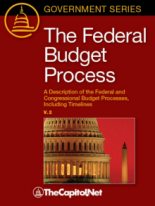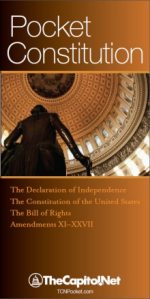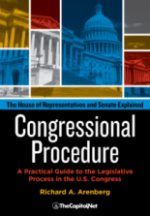From the Congressional Glossary – Including Legislative and Budget Terms
Budget Deficit / Budget Surplus
Lesson 1 National Debt & Budget Deficit Explained
The relationship between spending and revenues is reflected in the surplus or deficit figure. A surplus is an excess of revenues over outlays, while a deficit is an excess of outlays over revenues. Congress controls the enactment of legislation providing budget authority and raising revenues, but not the occurrence of outlays. Because of this, Congress’ efforts to control the level of the surplus or the deficit are less effective over the short run compared to the long run.
The difference between government revenues and outlays in a fiscal year equals the budget deficit or budget surplus. A budget deficit results when outlays exceed revenues; a budget surplus results when revenues exceed outlays. What is counted as government revenues and outlays, however, depends on the presentation of the federal budget. The federal budget typically is presented in the form of the unified budget, reflecting a unified budget deficit or surplus. The unified budget, or consolidated budget, includes the revenues and outlays of all budget accounts, including federal funds and trust funds, regardless of whether they are designated in law as on-budget or off budget. The unified budget represents a comprehensive picture of the federal government’s financial activities.
The federal budget also is presented to distinguish between on-budget and off-budget accounts. That is, the federal budget also presents an on-budget deficit or surplus and an off-budget deficit or surplus. The on-budget deficit or surplus includes all accounts not designated in law as off budget. The off-budget deficit or surplus includes those accounts designated in law as off-budget. Currently, there are three accounts designated in law as off-budget: the Federal Old-Age and Survivors Insurance Trust Fund (Social Security retirement), the Federal Disability Insurance Trust Fund (Social Security disability), and the Postal Service Fund.
Budget Deficits for Dummies: Or how I learned to stop worrying and love $1.4 trillion
To strengthen control over spending and deficit levels, and to promote more efficient legislative action on budgetary issues, Congress and the president enacted the Balanced Budget and Emergency Deficit Control Act of 1985. A key issue confronting the president and Congress in early 2011 was the need to raise the statutory limit on the public debt by a significant amount to accommodate the persistent, high deficits projected by the Office of Management and Budget (OMB) and the Congressional Budget Office (CBO). The resulting compromise was the the Budget Control Act of 2011.
The Budget Control Act (BCA) of 2011 contains many elements, including a phased increase in the statutory debt limit amounting to $2.1 trillion in total, a requirement that the House and Senate vote on a balanced-budget constitutional amendment by the end of 2011, and various changes in House and Senate budget procedures. The core elements, however, involve the reinstitution of statutory limits on discretionary spending and a process under which a Joint Select Committee on Deficit Reduction (the “Joint Committee”) is required to develop significant deficit-reduction legislation.
As long as the federal government incurs annual deficits and trust funds incur annual surpluses, the public-debt limit must be increased periodically. The frequency of congressional action to raise the debt limit has ranged in the past from several times in one year to once in several years.
Clarke and Dawe – Budgets. A Masterclass.
The Historical Tables in the president’s budget provide data, covering an extended time period, on receipts, budget authority, outlays, deficits and surpluses, federal debt, and other matters.
Also see
- Baseline Budgeting (CongressionalGlossary.com)
- Byrd Rule (CongressionalGlossary.com)
- Congressional Budget Act (CongressionalGlossary.com)
- Date Shifting / Fiscal Transparency / Fiscal Illusion (CongressionalGlossary.com)
- Federal Debt (CongressionalGlossary.com)
- Fiscal Year (CongressionalGlossary.com)
- Off-Budget / Off-Budget Entities (CongressionalGlossary.com)
- On-Budget (CongressionalGlossary.com)
- Outlay (CongressionalGlossary.com)
- Public Debt (CongressionalGlossary.com)
- Revenue (CongressionalGlossary.com)
- Statutory Limit on the Public Debt (CongressionalGlossary.com)
- Unified Budget (CongressionalGlossary.com)
- § 7.60 Spending, Revenue, and Debt-Limit Legislation, § 7.100 Debt-Limit Legislation, in Congressional Deskbook
- Chapter 7. The Congressional Budget and Other Special Cases, in Congressional Procedure
More
- Sequester / Sequestration (CongressionalGlossary.com)
- “‘Real’ Federal Deficit Four Times Official Number,” by Jason Sorens, Pileus, June 5, 2012
- Bureau of the Fiscal Service
- Federal Debt Basics – GAO
- Debt Subject to Limit Graph – Treasury Direct
- “The Debt Limit: History and Recent Increases,” CRS Report RL31967 (48-page PDF
 )
) - “Reducing the Budget Deficit: The President’s Fiscal Commission and Other Initiatives,” CRS Report R41784 (28-page PDF
 )
) - “The Uncertainty of Budget Projections: A Discussion of Data and Methods,” CBO Report, March 2007 (30-page PDF
 )
) - “Reducing the Budget Deficit: Policy Issues,” CRS Report R41778 (24-page PDF
 )
) - “The Congressional Budget Process Timetable,” CRS Report 98-472 (6-page PDF
 )
) - “The Congressional Budget Process: A Brief Overview,” CRS Report RS20095 (12-page PDF
 )
) - “Basic Federal Budgeting Terminology,” CRS Report 98-410 (6-page PDF
 )
) - “U.S. GAO – Federal Debt: Answers to Frequently Asked Questions – An Update,” GAO, GAO/OCG 99-87 (63-page PDF
 )
) - “Public Debt Ceiling: Its Current Status (1984),” CRS Report IB82081 (7-page PDF
 )
) - “Overview of the Federal Debt,” CRS Report R41815 (32-page PDF
 )
) - “Votes on Measures to Adjust the Statutory Debt Limit, 1978 to Present,” CRS Report R41814 (18-page PDF
 )
) - “The Debt Limit: The Need to Raise It After Four Years of Surpluses,” CRS Report RS21111 (8-page PDF
 )
) - “The Federal Government Debt: Its Size and Economic Significance,” CRS Report RL31590 (18-page PDF
 )
) - “Budget Process and Enforcement,” Parliamentary Boot Camp (4-page PDF
 )
) - “Federal Deficits, Growing Debt, and the Economy in the Wake of COVID-19,” CRS Report R46729 (24-page PDF
 )
) - “The Debt Limit Since 2011,” CRS Report R43389 (44-page PDF
 )
) - The Economic Effects of Financing a Large and Permanent Increase in Government Spending, Congressional Budget Office, CBO Working Paper 57201, March 2021 (42-page PDF
 )
) - “A National Disgrace: The federal budget process threatens America’s future.” By John Steele Gordon, City Journal, February 19, 2021
- “Clearing the Air on the Debt Limit,” CRS Report R45011 (33-page PDF
 )
)
Courses
- Congressional Operations Briefing – Capitol Hill Workshop
- Drafting Federal Legislation and Amendments
- Writing for Government and Business: Critical Thinking and Writing
- Custom Training
- Congressional Operations Poster, with Federal Budget Process Flowchart
- Federal Budgeting, a Five-Course series on CD
- Congress, the Legislative Process, and the Fundamentals of Lawmaking Series, a Nine-Course series on CD
Publications

The Federal Budget Process 2E

Pocket Constitution

Citizen’s Handbook to Influencing Elected Officials: A Guide for Citizen Lobbyists and Grassroots Advocates

Congressional Procedure
CongressionalGlossary.com, from TheCapitol.Net
For more than 40 years, TheCapitol.Net and its predecessor, Congressional Quarterly Executive Conferences, have been teaching professionals from government, military, business, and NGOs about the dynamics and operations of the legislative and executive branches and how to work with them.
Our custom on-site and online training, publications, and audio courses include congressional operations, legislative and budget process, communication and advocacy, media and public relations, testifying before Congress, research skills, legislative drafting, critical thinking and writing, and more.
TheCapitol.Net is on the GSA Schedule, MAS, for custom on-site and online training. GSA Contract GS02F0192X
TheCapitol.Net is now owned by the Sunwater Institute.
Teaching how Washington and Congress work ™

